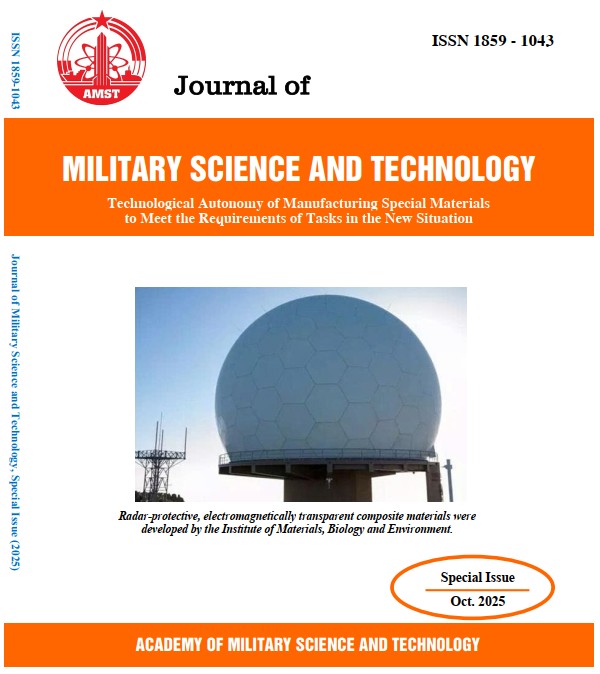Study on the composition, microstructure, and technological orientation for the fabrication of piezoelectric ceramics used in special transducers for underwater acoustics
DOI:
https://doi.org/10.54939/1859-1043.j.mst.IMBE.2025.8-14Keywords:
Piezoelectric ceramics; Sonar complex MGK-400EM; OCT 11 0444-87.Abstract
The paper presents research results on the composition and microstructure of piezoelectric ceramics currently used in transducers. Based on these results, a technological approach is proposed for fabricating disk-shaped piezoelectric ceramics intended for the 1H antenna of the MGK-400EM sonar system. The results show that the piezoelectric ceramic is lead-based, with an apparent density of 7.378 g/cm³, surfaces are coated with Ag, with an average thickness of 17.07 μm. The ceramic matrix consists of fine, uniform grains with an average size of ~5 μm. The EDX analysis results show that the main elements are homogeneous distributed by weight are 43.29% Pb, 10.53% Ba, 16.59% Zr, 5.87% Ti, 22.87% O, and 0.85% Sr. In this system, Sr acts as a dopant equivalent to that in the PZT-based piezoelectric ceramic system. The sample contains the phases Pb(Zr0.525Ti0.475)O3 and Pb(Zr0.52Ti0.48)O3 with a perovskite structure, where the Zr/Ti ratios (~0.525/0.475 and 0.52/0.48) correspond to the morphotropic phase boundary (MPB). Raman spectra reveal the coexistence of orthorhombic, tetragonal, and monoclinic phases, which ensures optimal piezoelectric properties. Based on these research results, a fabrication technology using the solid-state reaction method is oriented and proposed.
References
[1]. Naval Technical Department, “Hướng dẫn sử dụng tổ hợp sonar MGK-400EM, Phần 1 Thuyết minh hướng dẫn sử dụng”, (2012) (in Vietnamese).
[2]. Михаил Валерьевич Богуш, Ольга Михайловна Богуш, Эдуард Михайлович Пикалев, “Анализ температурных напряжений в элементах гидроакустических антенн (Thermal stresses analysis in the elements of sonar antenna)”, Приборы, 10, 38–42, (2013).
[3]. Tran Van Quynh et al., “Công nghệ vật liệu điện tử”, Science and Technology Publishing House, (2006) (in Vietnamese).
[4]. OCT 11 0444-87, “Материалы пьезокерамические”, Технические условия, (1987).
[5]. Топчиев Анатолий Андреевич, “Влияние модификаторов на диэлектрические свойства и формирование структуры керамики на основе цирконата-титаната свинца”, Диссертация кандидата физико-математических наук, (2021).
[6]. Małgorzata Adamczyk-Habrajska et al., “Impedance Spectroscopy of Lanthanum-Doped (Pb0.75Ba0.25)(Zr0.7Ti0.3)O3 Ceramics”, Applied Sciences, 14(21), 9854, (2024).
[7]. Chakkaphan Wattanawikkam et al., “Crystal structure and microstructure of (Pb1−xBax)(Zr1−yTiy)O3 ceramics prepared by the solid state reaction method”, Ferroelectrics, 403(1), 166–174, (2010).
[8]. R. Kalaivani et al., “Synthesis of chitosan mediated silver nanoparticles (Ag NPs) for potential antimicrobial applications”, Frontiers in Laboratory Medicine, 2(1), 30–35, (2018).
[9]. W. R. Jaffe et al., “Piezoelectric Ceramics”, Academic Press, New York, (1971).
[10]. Amid Shakeri et al., “An investigation of solvent effect on rhombohedral/monoclinic/tetragonal phase properties of Pb(Zr0.53Ti0.47)O3 nanoparticles prepared via sol-gel method”, Advanced Materials Research, 829, 698–702, (2014).
[11]. Mirta Mir et al., “X-ray powder diffraction structural characterization of Pb1−xBaxZr0.65Ti0.35O3 ceramic”, Structural Science, 63(5), 713–718, (2007).
[12]. B. Noheda et al., “Stability of the monoclinic phase in the ferroelectric perovskite PbZr1−xTixO3”, Physical Review B, 63(1), 014103, (2000).







